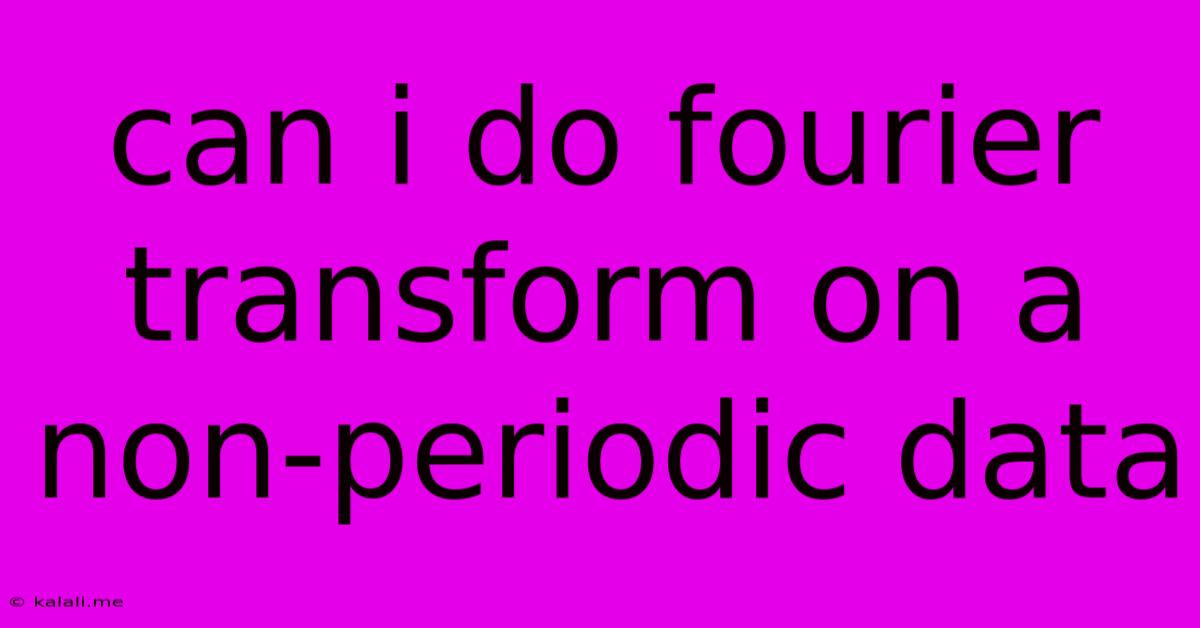Can I Do Fourier Transform On A Non-periodic Data
Kalali
Jun 02, 2025 · 3 min read

Table of Contents
Can I Do a Fourier Transform on Non-Periodic Data? The Short Answer: Yes, But…
The Fourier Transform (FT) is a powerful mathematical tool used to decompose a function into its constituent frequencies. While it's often introduced with a focus on periodic signals, the reality is you can absolutely apply it to non-periodic data. However, the method and interpretation require a nuanced understanding. This article explores the nuances of applying the FT to non-periodic data, highlighting the key differences and implications.
Understanding the Fourier Transform's Core Principle: At its heart, the Fourier Transform breaks down a function into a sum of sine and cosine waves of different frequencies and amplitudes. While periodic functions have a discrete set of frequencies, non-periodic functions contain a continuous spectrum of frequencies.
The Discrete Fourier Transform (DFT) and its Limitations: When dealing with digital data (which is almost always the case in practical applications), we use the Discrete Fourier Transform (DFT). The DFT assumes the input data represents one period of a periodic signal. If your data is truly non-periodic, forcing it into the DFT framework can lead to artifacts, specifically:
- Spectral Leakage: Non-periodic data, when treated as periodic, will "wrap around" in the frequency domain, causing energy from one frequency to bleed into others. This manifests as spurious peaks in the frequency spectrum.
- Gibbs Phenomenon: Sharp discontinuities in the non-periodic data can lead to oscillations near these discontinuities in the frequency spectrum, making it difficult to accurately determine the true frequency components.
The Solution: Windowing and the Discrete-Time Fourier Transform (DTFT)
To mitigate these problems, several techniques are employed:
-
Windowing: Before applying the DFT, a window function is applied to the data. This function smoothly tapers the data to zero at the edges, reducing the abrupt transitions that cause spectral leakage. Popular window functions include the Hamming, Hanning, and Blackman windows. Each window has trade-offs between reducing leakage and preserving resolution. The choice of window depends heavily on the nature of the signal and the desired balance between these competing factors.
-
Zero-Padding: Adding zeros to the end of the data sequence before applying the DFT can improve the frequency resolution of the resulting spectrum. This does not solve spectral leakage but offers a finer frequency grid for analysis.
-
Understanding the DTFT: Strictly speaking, the continuous Fourier Transform is designed for non-periodic signals. The DFT is a sampled version of the DTFT. Understanding the DTFT provides a clearer framework for interpreting the DFT results obtained from finite-length, non-periodic signals. It acknowledges the inherent limitations of working with finite-length data and provides a way to understand how the DFT approximates the continuous frequency spectrum.
Choosing the Right Approach:
The best approach depends on your specific application and the nature of your data.
-
For signals with clear periodic components alongside non-periodic features: Windowing techniques are often sufficient to obtain a meaningful frequency analysis.
-
For signals with a complex and primarily non-periodic nature: More sophisticated time-frequency analysis techniques like the Short-Time Fourier Transform (STFT) or Wavelet Transform might be more appropriate, offering better time-frequency resolution.
In Conclusion:
You can indeed perform a Fourier Transform on non-periodic data, but understanding the limitations and applying appropriate techniques like windowing and zero-padding is crucial for obtaining accurate and meaningful results. The choice of method should be tailored to the specific characteristics of your data and the goals of your analysis. The inherent limitations of the DFT when dealing with non-periodic signals highlight the importance of understanding the underlying mathematical principles and choosing the most suitable analytical approach. Remember that the interpretation of the results should always consider the employed window function and its effect on the spectrum.
Latest Posts
Latest Posts
-
A Wise Man Proportions His Belief To The Evidence
Jun 04, 2025
-
Can Iron Golems Go In Minecarts
Jun 04, 2025
-
How To Use Self Leveling Concrete
Jun 04, 2025
-
Why Is My Tub Faucet Leaking
Jun 04, 2025
-
17 Inch Frame Bike With 26 Inch Wheels
Jun 04, 2025
Related Post
Thank you for visiting our website which covers about Can I Do Fourier Transform On A Non-periodic Data . We hope the information provided has been useful to you. Feel free to contact us if you have any questions or need further assistance. See you next time and don't miss to bookmark.